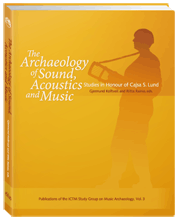The Mammoth in the Room: Did Musical Necessity Drive Innovation in Ancient Technology?
Graeme Lawson
Some years ago the cognitive psychologist Steven Pinker (1997: 534) ruffled feathers when he argued that, in terms of their evolutionary significance, the musical aptitudes of modern humans might be no more than “auditory cheesecake”, a lucky by-product of more important capacities for language and speech which (he surmised) had long since evolved amongst our primate forbears.
The disciplines of Ancient Studies too have often seemed reluctant to accord music a meaningful role in processes of cultural change, despite the growing weight of archaeological evidence. This article takes up the challenge. Adopting a broad diachronic perspective, archaeological finds are introduced which illustrate music’s frequent proximity not only to power but also to innovation. Such cases prompt us to ask: do such connexions reveal musics to be merely taking advantage of opportunities afforded by new technologies, or might they be doing something else entirely? Might they in fact be active, catalysts of change? Remarkably, it seems to be precisely in relation to music that some ancient industries find their most sophisticated and technically demanding expression.
Theese cases suggest that archaeological theory should be paying closer attention to innovation and change in musical tool-making behaviours.The time has come for archaeology to re-engage with its musical materials and to invest in their study. We need to start taking music more seriously.




